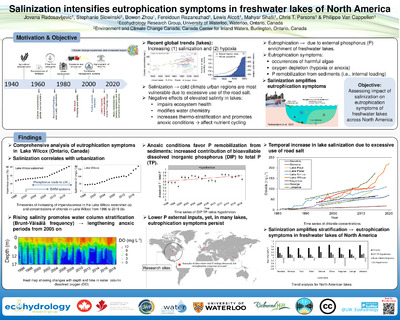| dc.contributor.author | Radosavljevic, Jovana | |
| dc.contributor.author | Slowinski, Stephanie | |
| dc.contributor.author | Zhou, Bowen | |
| dc.contributor.author | Parsons, Chris T. | |
| dc.contributor.author | Rezanezhad, Fereidoun | |
| dc.contributor.author | Alcott, Lewis | |
| dc.contributor.author | Shafii, Mahyar | |
| dc.contributor.author | Van Cappellen, Philippe | |
| dc.date.accessioned | 2023-06-15 19:34:42 (GMT) | |
| dc.date.available | 2023-06-15 19:34:42 (GMT) | |
| dc.date.issued | 2023-05 | |
| dc.identifier.uri | http://hdl.handle.net/10012/19546 | |
| dc.description.abstract | The acceleration of global urbanization continues to fuel concerns surrounding water quality impairments in urban lakes, particularly their eutrophication. Eutrophication of freshwater environments is generally assumed to be driven by the anthropogenic augmentation of phosphorus (P) supplies which can alleviate limitations on primary production. Salinization is also recognized as a stressor on urban freshwater quality, particularly in cold climate regions in which salts are applied to road surfaces as de-icing agents. While the ecological damages caused by P enrichment and salinization to freshwaters are both well established, thus far, their impacts on water quality have only been considered independently. Although improvements to the management of urban stormwater and wastewater have decreased P inputs to freshwater systems in recent decades, many lakes worldwide remain eutrophic, as indicated by declining dissolved oxygen (DO) concentrations and rising dissolved inorganic P (DIP) concentrations in their hypolimnions. Here we present an analysis of multiple decades of water chemistry data for several urban lakes in North America (Ontario, Wisconsin, and Minnesota) to demonstrate that salinization associated with impervious land cover expansion is driving increases to anoxia and the prevalence of internal P loading, exacerbating eutrophication. Our trend analysis shows progressive salinization (observed through significant increases in chloride or electrical conductivity) of all the lakes investigated, which strengthens their thermal stratification (calculated using the Brunt-Väisälä frequency). The increasing salinity trends are accompanied by increasing hypolimnion hypoxia and increasing DIP:TP in all lakes, thereby demonstrating the mechanistic link between salinization and eutrophication. Rising salinity intensifies water column stratification, in turn, reducing the oxygenation of the hypolimnion and enhancing internal P loading from the sediments. These results highlight that stricter management of de-icing salt application rates should be considered to control lake eutrophication symptoms in cold climate regions. | en |
| dc.description.sponsorship | Financial support was provided by a Natural Science and Engineering Research Council of Canada (NSERC) Strategic Partnerships Grant (STPGP 521515-18), and the Lake Futures project and Managing Urban Eutrophication Risks under Climate Change project within the Global Water Futures (GWF) program funded by the Canada First Research Excellence Fund (CFREF). | en |
| dc.language.iso | en | en |
| dc.publisher | University of Waterloo | en |
| dc.relation.ispartofseries | Global Water Futures; | |
| dc.rights | Attribution-NonCommercial-NoDerivatives 4.0 International | * |
| dc.rights.uri | http://creativecommons.org/licenses/by-nc-nd/4.0/ | * |
| dc.subject | salinization | en |
| dc.subject | urban lakes | en |
| dc.subject | internal loading | en |
| dc.subject | phosphorus | en |
| dc.subject | GWF AOSM 2023 | en |
| dc.title | Salinization increases eutrophication symptoms in freshwater urban lakes of North America | en |
| dc.type | Conference Poster | en |
| dcterms.bibliographicCitation | Radosavljevic, J; Slowinski, S; Zhou, B; Razanezhad, F; Alcott, L; Shafii, M; Parsons, C.T & Van Cappellen, P. (2023) Salinization intensifies eutrophication systems in freshwater lakes of North America. Global Water Futures (GWF) Annual Open Science Meeting Conference. University of Waterloo. | en |
| uws.contributor.affiliation1 | Faculty of Science | en |
| uws.contributor.affiliation2 | Earth and Environmental Sciences | en |
| uws.typeOfResource | Text | en |
| uws.peerReviewStatus | Unreviewed | en |
| uws.scholarLevel | Graduate | en |


